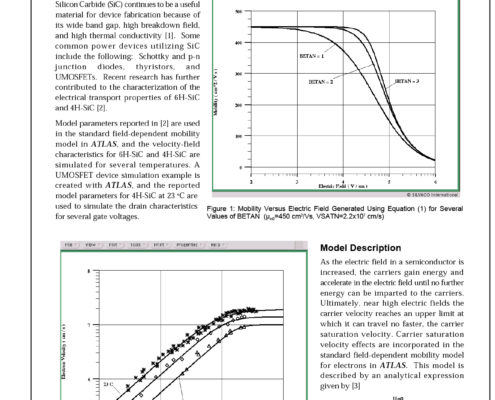
ATLAS Field Dependent Mobility: Model Parameters for (0001) 6H-SiC and (0001) 4H-SiC
For high temperature, high power applications Silicon Carbide (SiC) continues to be a useful material for device fabrication because of its wide band gap, high breakdown field, and high thermal conductivity [1]. Some common power devices utilizing SiC include the following: Schottky and p-n junction diodes, thyristors, and UMOSFETs. Recent research has further contributed to the characterization of the electrical transport properties of 6H-SiC and 4H-SiC [2].
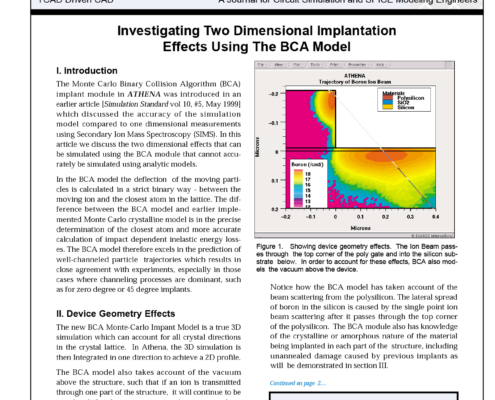
Investigating Two Dimensional Implantation Effects Using The BCA Model
The Monte Carlo Binary Collision Algorithm (BCA) implant module in ATHENA was introduced in an earlier article [Simulation Standard Vol 10, #5, May 1999] which discussed the accuracy of the simulation model compared to one dimensional measurements using Secondary Ion Mass Spectroscopy (SIMS). In this article we discuss the two dimensional effects that can be simulated using the BCA module that cannot accurately be simulated using analytic models.
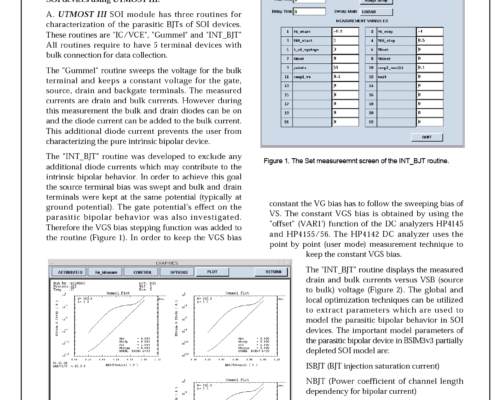
Hints & Tips January 1999
A. UTMOST III SOI module has three routines for characterization of the parasitic BJTs of SOI devices. These routines are "IC/VCE", "Gummel" and "INT_BJT" All routines require to have 5 terminal devices with bulk connection for data collection.
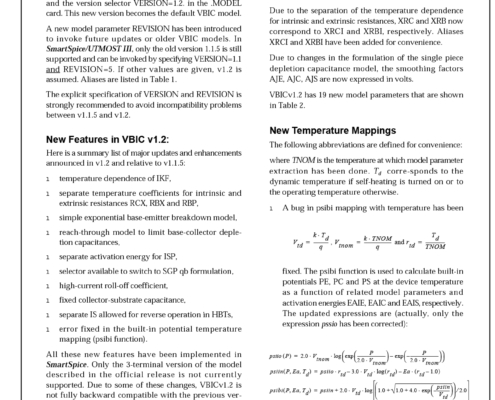
VBIC Version 1.2 Released in SmartSpice and UTMOST III
The latest VBIC bipolar model v1.2 of Sep 24 1999 has been integrated into SmartSpice and UTMOST III. It can be invoked by specifying the model selector LEVEL=5 and the version selector VERSION=1.2. in the .MODEL card. This new version becomes the default VBIC model.
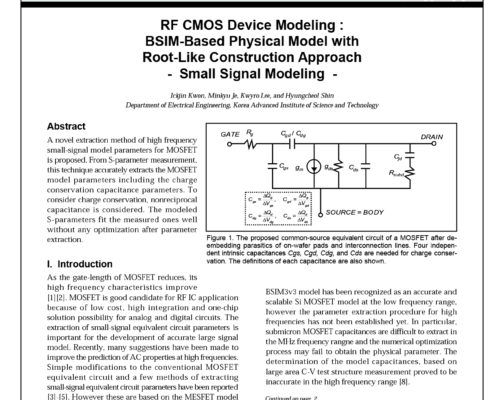
RF CMOS Device Modeling: BSIM-Based Physical Model with Root-Like Construction Approach – Small Signal Modeling
A novel extraction method of high frequency small-signal model parameters for MOSFET is proposed. From S-parameter measurement, this technique accurately extracts the MOSFET model parameters including the charge conservation capacitance parameters. To consider charge conservation, nonreciprocal capacitance is considered. The modeled S-parameters fit the measured ones well without any optimization after parameter extraction.
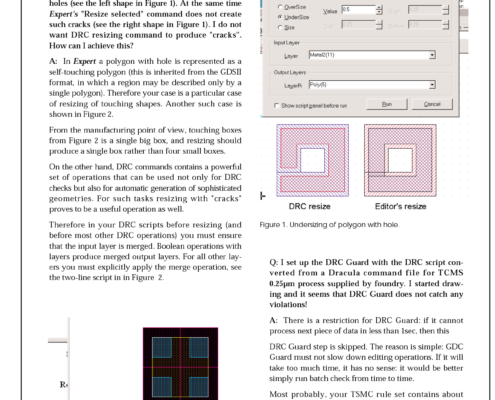
Hints & Tips December 1999
Q: I tried to resize shapes using the DRC command and observed thin "cracks" appeared for polygons with holes (see the left shape in Figure 1). At the same time Expert's "Resize selected" command does not create such cracks (see the right shape in Figure 1). I do not want DRC resizing command to produce "cracks". How can I achieve this?
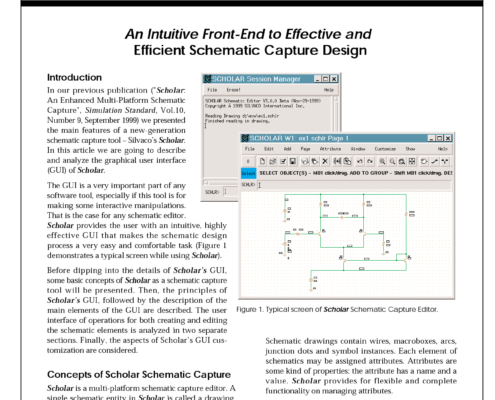
An Intuitive Front-End to Effective and Efficient Schematic Capture Design
In our previous publication ("Scholar: An Enhanced Multi-Platform Schematic Capture", Simulation Standard, Vol.10, Number 9, September 1999) we presented the main features of a new-generation schematic capture tool - Silvaco's Scholar. In this article we are going to describe and analyze the graphical user interface (GUI) of Scholar.
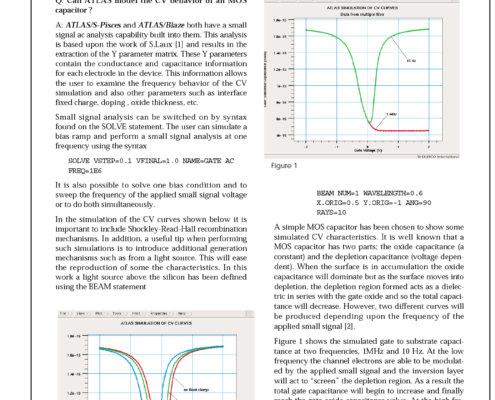
Hints & Tips November 1999
A: ATLAS/S-Pisces and ATLAS/Blaze both have a small signal ac analysis capability built into them. This analysis is based upon the work of S.Laux [1] and results in the extraction of the Y parameter matrix. These Y parameters contain the conductance and capacitance information for each electrode in the device. This information allows the user to examine the frequency behavior of the CV simulation and also other parameters such as interface fixed charge, doping , oxide thickness, etc.
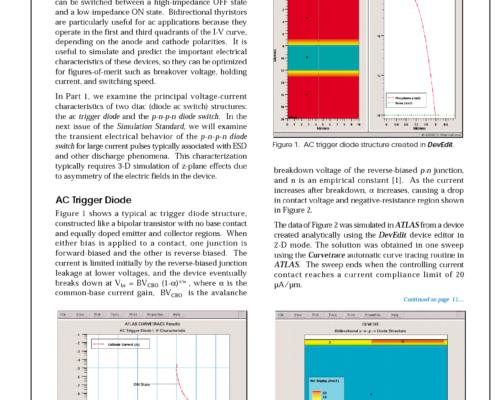
Modeling Bidirectional Thyristors Using ATLAS
Thyristors are semiconductor devices that exhibit multi-stable or bi-stable electrical characteristics, and can be switched between a high-impedance OFF state and a low-impedance ON state. Bidirectional thyristors are particularly useful for ac applications because they operate in the first and third quadrants of the I-V curve, depending on the anode and cathode polarities. It is useful to simulate and predict the important electrical characteristics of these devices, so they can be optimized for figures-of-merit such as breakover voltage, holding current, and switching speed.
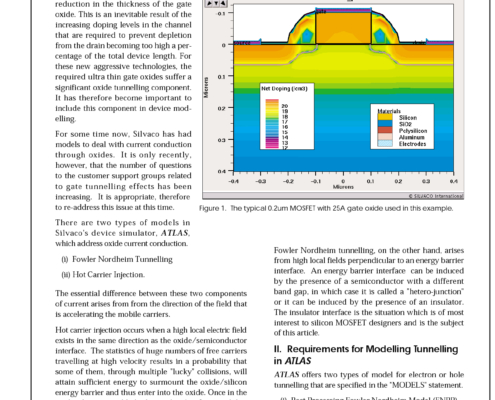
Modelling Tunneling Currents in Ultra Thin Oxides
Ever decreasing minimum geometries in MOSFET design results in a corresponding reduction in the thickness of the gate oxide. This is an inevitable result of the increasing doping levels in the channel that are required to prevent depletion from the drain becoming too high a percentage of the total device length. For these new aggressive technologies, the required ultra thin gate oxides suffer a significant oxide tunnelling component. It has therefore become important to include this component in device modelling.
